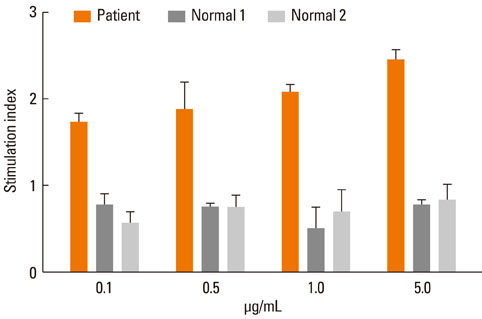Allergy Asthma Immunol Res.
2012 Sep;4(5):309-310. 10.4168/aair.2012.4.5.309.
A Case of Allopurinol-Induced Fixed Drug Eruption Confirmed With a Lymphocyte Transformation Test
- Affiliations
-
- 1Department of Internal Medicine, Seoul National University College of Medicine, Seoul, Korea. helenmed@snu.ac.kr
- 2Institute of Allergy and Clinical Immunology, Seoul National University Medical Research Center, Seoul, Korea.
- 3Department of Internal Medicine, Dongguk University Ilsan Hospital, Goyang, Korea.
- KMID: 2167051
- DOI: http://doi.org/10.4168/aair.2012.4.5.309
Abstract
- Allopurinol is one of the causative drugs that induce fixed drug eruption (FDE). The lymphocyte transformation test (LTT) is a safe and reliable diagnostic procedure for drug allergy, but is reported to be rarely positive in patients with FDE. In the current case, we performed an LTT and successfully confirmed allopurinol as the offending drug. This case report suggests that an LTT should be an optional diagnostic tool for FDE or delayed reaction due to allopurinol.
MeSH Terms
Figure
Cited by 1 articles
-
Allopurinol-induced severe cutaneous adverse reactions: A report of three cases with the HLA-B*58:01 allele who underwent lymphocyte activation test
Eun-Young Kim, Jung Eun Seol, Jae-Hyeog Choi, Na-Yul Kim, Jae-Gook Shin
Transl Clin Pharmacol. 2017;25(2):63-66. doi: 10.12793/tcp.2017.25.2.63.
Reference
-
1. Shiohara T. Fixed drug eruption: pathogenesis and diagnostic tests. Curr Opin Allergy Clin Immunol. 2009. 9:316–321.2. Andrade P, Brinca A, Gonçalo M. Patch testing in fixed drug eruptions--a 20-year review. Contact Dermatitis. 2011. 65:195–201.3. Nyfeler B, Pichler WJ. The lymphocyte transformation test for the diagnosis of drug allergy: sensitivity and specificity. Clin Exp Allergy. 1997. 27:175–181.4. Kano Y, Hirahara K, Mitsuyama Y, Takahashi R, Shiohara T. Utility of the lymphocyte transformation test in the diagnosis of drug sensitivity: dependence on its timing and the type of drug eruption. Allergy. 2007. 62:1439–1444.5. Umpiérrez A, Cuesta-Herranz J, De Las Heras M, Lluch-Bernal M, Figueredo E, Sastre J. Successful desensitization of a fixed drug eruption caused by allopurinol. J Allergy Clin Immunol. 1998. 101:286–287.6. Mahboob A, Haroon TS. Drugs causing fixed eruptions: a study of 450 cases. Int J Dermatol. 1998. 37:833–838.7. Kelso JM, Keating RM. Successful desensitization for treatment of a fixed drug eruption to allopurinol. J Allergy Clin Immunol. 1996. 97:1171–1172.8. Teraki Y, Shiohara T. Successful desensitization to fixed drug eruption: the presence of CD25+CD4+ T cells in the epidermis of fixed drug eruption lesions may be involved in the induction of desensitization. Dermatology. 2004. 209:29–32.9. Santiago F, Gonçalo M, Vieira R, Coelho S, Figueiredo A. Epicutaneous patch testing in drug hypersensitivity syndrome (DRESS). Contact Dermatitis. 2010. 62:47–53.10. Pichler WJ, Tilch J. The lymphocyte transformation test in the diagnosis of drug hypersensitivity. Allergy. 2004. 59:809–820.
- Full Text Links
- Actions
-
Cited
- CITED
-
- Close
- Share
- Similar articles
-
- Fixed Drug Eruption Due to Allopurinol: Positive Oral Provocation
- A Case of Cycloserine-Induced Lichenoid Drug Eruption Supported by the Lymphocyte Transformation Test
- Generalized Multiple Fixed Drug Eruption
- Fluconazole Induced Fixed Drug Eruption
- A Case of Fixed Drug Eruption by Piroxicam: Cross Antigenicity between Piroxicam and Meloxicam


